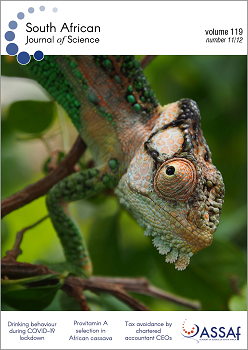Occurrence, quantification and removal of triclosan in wastewater of Umbogintwini Industrial Complex in KwaMakhutha, South Africa
DOI:
https://doi.org/10.17159/sajs.2023/14743Keywords:
molecularly imprinted membranes, persistent organic pollutants, phase inversion, triclosan, wastewaterAbstract
We report on the detection of an organic pollutant mostly found in local streams and wastewater treatment plants, specifically on triclosan detected in the Umbogintwini Industrial Complex (UIC), located on the south coast of Durban, KwaZulu-Natal in South Africa. Triclosan was successfully extracted from effluent samples using molecularly imprinted membrane adsorbents (MIMs) before quantification and removal using high-performance liquid chromatography (HPLC). This was done through fabrication of a polyvinylidene fluoride polymer using selective microparticles and molecularly imprinted polymers by means of phase inversion and an immersion precipitation method which results in enhanced hydrophilicity and membrane performance. The optimisation of experimental parameters – i.e. contact time and sample size – was performed through different stages of analysis. The synthesised MIMs exhibited an outstanding adsorption efficiency of 97% for triclosan in relation to those of non-imprinted membranes (NIMs) and pristine membranes at 92% and 88%, respectively. The analytical method employed had limits of detection and quantification of 0.21 and 0.69 parts per billion (ppb or μg/L) in wastewater effluent, respectively. The obtained efficiency results show great potential for future use of membrane and molecular imprinting technology, and that MIMs can be adopted as adsorbents for water treatment. The fast and highly selective methodology presented in this work could also be employed for the examination of persistent organic pollutants in the future to combat water scarcity in South Africa.
Significance:
The key finding of this work is the incorporation of molecularly imprinted polymers with a membrane adsorbent to improve the performance of the membrane. An unexpected finding was the existence of pollutants like triclosan in water within the boundaries of the KwaMakhutha community, near the human settlement. Among the MIMs, NIMs and bare membranes, higher removal efficiencies were displayed by the synthesised MIMs against the discovered pollutants. This work could open doors for advanced research in the community.
Published
Issue
Section
License

All articles are published under a Creative Commons Attribution 4.0 International Licence
Copyright is retained by the authors. Readers are welcome to reproduce, share and adapt the content without permission provided the source is attributed.
Disclaimer: The publisher and editors accept no responsibility for statements made by the authors
How to Cite
- Abstract 500
- PDF 561
- EPUB 136
- XML 189
Funding data
-
National Research Foundation
Grant numbers MND190619448884













.png)